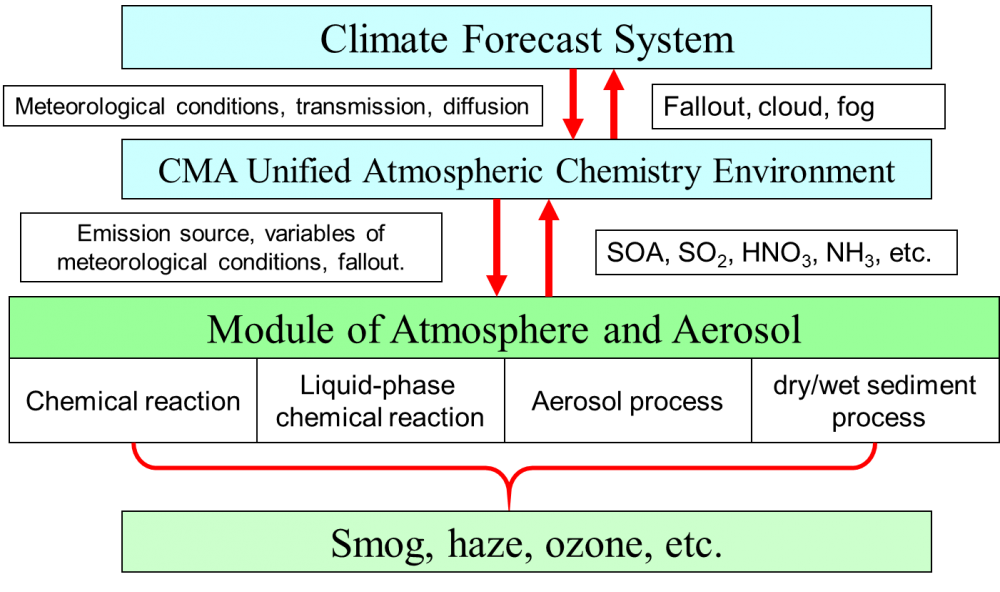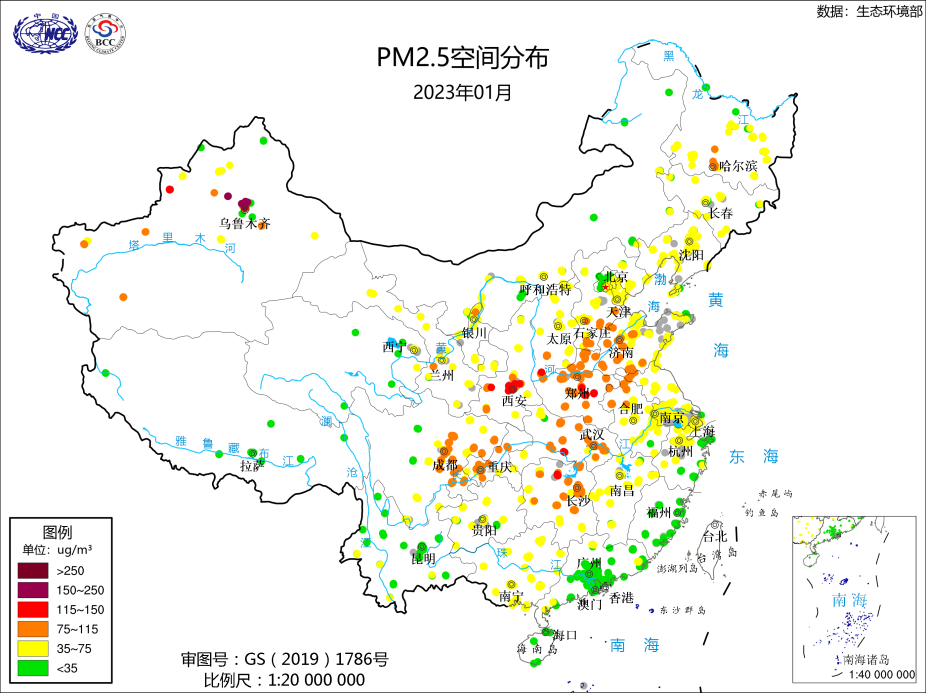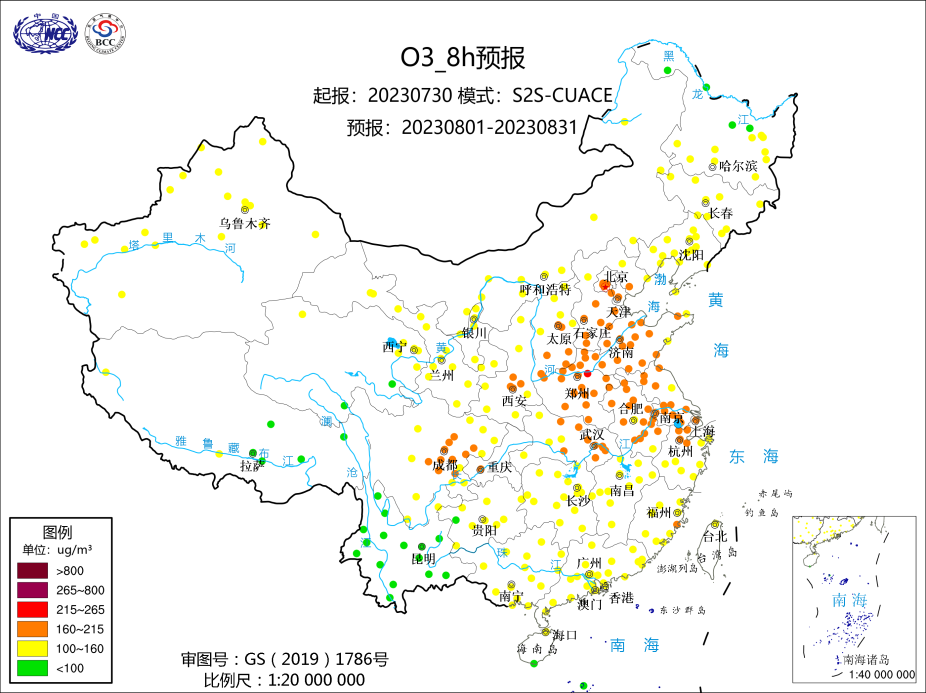![]() Monitoring and Prediction of Air Pollution
Monitoring and Prediction of Air Pollution
Air pollution is harmful to public health and environment. The polluted air would reduce visibility and block sunlight, causing acid rain and have negative impact on forests, wildlife and agriculture. Moreover, as one of the cause of climate change, greenhouse gas pollution, could affects the entire planet. The problem of air pollution has been exacerbated by ever growing number of automobiles, industrial output pollution, transportation fuel consumption, and energy generation. Therefore, accurate prediction of air pollution is a crucial task.

Figure 1 Schematic Diagram of S2S-CUACEv1.0
Beijing Climate Centre (BCC) operationally issues prediction of air diffusion condition since 2017, in cooperation with China National Environmental Monitoring Centre (CNEMC). The monitoring and prediction products include subseasonal to seasonal prediction of meteorological background relative to the diffusion conditions of air pollutants, extended range forecast of starting & ending times and intensity of main pollution processes, etc (Figure 2). Forecast verification of main pollution processes for key regions, e.g. Beijing, Tianjin and 26 cities in nearby provinces, and 11 cities in the Fenhe and Weihe river plains, as well as 41 cities in the Yangtze River Delta. Besides the operational monitoring and prediction, BCC provides predictive service for important activities irregularly, such as the annual National People’s Congress (NPC) and the Chinese People’s Political Consultative Conference (CPPCC), China International Import Expo (CIIE, Shanghai), etc. BCC also actively participated in the national strategy of “three-year action plan to win the battle of blue sky defense” by providing forecast products, data sharing and consulting services.

Figure 2. Monitoring of spatial distribution of PM2.5 concentration in January 2023
The atmospheric movement itself has a cleaning effect on pollutants in the atmosphere, such as the strong wind accompanied by cold air process has diffusion and dilution effects. Precipitation has a wet removal effect on atmospheric pollutants. Similar to the purification ability of water, the diffusion, dilution and wet removal effects was defined as the air self-cleaning ability. The air self-cleaning ability is not related to the emissions of air pollutants, and can be used to quantify the contribution of changed atmospheric conditions on air pollution, evaluate the implementation effect of air pollution prevention and control measures. On the other hand, it serves as an index of air pollution potential, provide guidance for the air pollution prevention and control measures. Thus, the prediction of air pollution is not focus on the atmospheric pollutant, but the meteorological conditions.
There are two operational prediction systems in BCC, i.e. Subseasonal Prediction System of Air Pollution (SPSAP) and Climate Prediction System of Atmospheric Pollution Potential (CPSAPP). Both prediction systems are constructed based on the combination of Dynamical Extended Range Forecast model system (DERF) and the downscaling of Weather Research & Forecasting Model (WRF). The historical simulation experiment showed that the system cold forecast the process of heavy air pollution events 15 days in advance in most cases, and the forecast accuracy depends on the DERF to a considerable extent. The products of SPSAP are mostly graphical, which includes daily & monthly forecast of main pollutants in key regions (PM2.5, PM10, O3, etc.) and relative meteorological variables (visibility, precipitation, 2m temperature, humidity and surface winds, etc.) (Figure 3, 4). The products of CPSAPP include daily forecast of air self-purification capacity, 10m wind speed, depths of mixed layer, ventilation quantity and precipitation in the next 40 days. CPSAPP also provides daily, pentad and weekly forecast of national and regional index of air self-purification capacity, depths of mixed layer and precipitation.

Figure 3. Prediction of spatial distribution of monthly PM2.5 concentration in August 2023

Figure 4. Prediction of spatial distribution of monthly ozone (O3) concentration in August 2023
Forecast verification is an essential component of air pollution prediction, since it provides information about the quality of the forecasts and guidance for users. The verification results also provide guidance for the development of new forecast technology and improvement of predictive system. BCC is responsible for the assessment of prediction of air pollution processes in key regions. The target variables in operational forecast verification include days of pollution, the number of main air pollution processes and its intensity.
Friendly link
Links to GPC websites
Links to NMHSs in RA II
Copyright:© 2005 ~ 2023 Beijing Climate Centre. All rights reserved. Technical support: zhongyan
address:46 South Street, Zhongguancun, Haidian District, Beijing Zip code:100081
Today:04540/Total:34031133